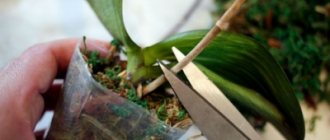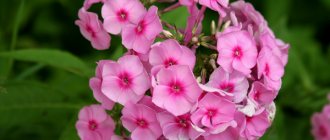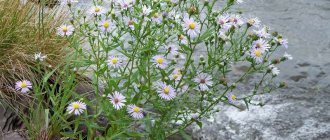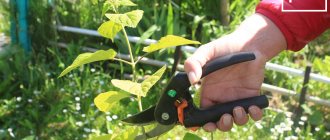Yandex.RTB RA-1479455-7
Most often, clematis is cultivated in the ground, but it will also feel quite comfortable as a houseplant.
It is usually planted in pots, boxes or tubs (at least 60 cm high), placed in a well-lit place. Several holes must be made in the bottom of the container, then drainage and fertile soil are filled in, and after planting, a support for the plant must be installed. To provide the roots with coolness and shading, low-growing “neighbors” are planted in a pot of clematis.
Variety “Polish Spirit” combined with hyssop, rose and hosta
Yandex.RTB RA-1479455-3
Clematis planting and care in open ground.
Indeed, choosing your variety from this variety of luxurious flowers is quite difficult. One is more beautiful than the other - huge, bright, terry, each simply strives to outshine the others in beauty. Each type promises to turn our dacha into a real Garden of Eden! After all, any variety looks beautiful both on its own and in combination with other flowers, especially roses.
Yandex.RTB RA-1479455-8
One of the most beautiful and sought-after varieties of clematis is Clematis Manchurian. This beautiful vine is actively used to decorate the landscape of the yard by gardeners all over the world, but only in the last few years has gardeners in our country paid attention to it. Thanks to its snow-white beauty and ease of care.
Clematis Manchurian (photo)
But, because We plan not just to admire the flower, but to grow it, then we need to know the features of caring for it. It is best to buy seedlings in pots, and when choosing a variety, we first look not at the shape of the flower, but at its group. It is she who will determine how we prune it, how to cover it for the winter and when to expect it to bloom.
Types of clematis by group and pruning method:
- First group. The liana will produce flowers only on last year's shoots. Therefore, if you cut off all the old shoots in the winter or spring, you will never see flowering. Flowers from this group are the most luxurious, fashionable and amazing, but they definitely need to be covered for the winter.
- Second group. In these varieties, flowers appear both on last year's shoots and on new shoots. But, if the variety is double, double flowers appear only on last year’s shoots. Only simple-shaped inflorescences appear on young shoots and with a short break after the first flowers on old shoots.
- Third group. Flowers appear only on young shoots. There is no need to cover it - I cut it almost to the root and that’s it. These species are the most unpretentious - they are ideal varieties for beginners, because... Caring for the liana is simple and straightforward. And although there are almost no terry species in this group, believe me, there is plenty to choose your treasure from.
Variety ERNEST MARKHAM. Group 3, height 2.5 m
HISTORY OF CLEMATIS
There are many natural species of clematis that grow wild in Japan, Korea, Australia, New Zealand and both American continents.
A beautiful climbing plant came to Europe from the East at the beginning of the 18th century. The French especially loved it. It was here that the first large-flowered vines with unusual bright colors of flowers were bred, which decorated the walls of houses and decorated high stone fences.
The vine was brought to Russia at the beginning of the 19th century to decorate palace walls, gazebos and pavilions. A very unpretentious plant quickly spread throughout the country.
The selection of clematis in our country began to be seriously pursued only in the 50s of the last century. Scientists and breeders of the Nikitsky Botanical Garden were the first to begin this work.
To date, more than 2.5 thousand varieties of this stunningly beautiful vine have been created in the world. Among them you can find plants from 1.5 to 25 m in length and with amazingly beautiful bright (single-color and multi-color) small and large (from 2 to 25 cm in diameter) flowers of the most bizarre shapes and with a variety of aromas.
Clematis are very unpretentious and durable. Even with little care, they will delight you for many years with their amazing sophisticated beauty and lush flowering.
Planting clematis - tips for beginner gardeners
When you solve the problem of how to grow healthy clematis, remember that it does not tolerate transplantation at all, so immediately plant them in a permanent place. And in this place it can grow for up to 40 years, provided that you have prepared the planting hole correctly.
Clematis Comtesse de Bouchaud photo
How to preserve a seedling before planting.
If you bought your plant in the supermarket in early spring and still need to get to your dacha, or perhaps it’s still too cold to plant, you need to make friends with the plant at home.
Place the pot with the seedling on the sunniest windowsill. Now we must disinfect the soil in the pot, because... here it’s better to play it safe than to hope that it will pass - you don’t want to then treat diseases in our vine. We use Fitosporin for the soil. And in order to support the small vine itself, we use spraying with Epin solution. And for the roots we will buy vermicompost (instructions on the label). We repeat these procedures every ten days.
How to plant clematis yourself correctly.
A seedling in a pot can be transplanted into the soil after the night frosts have passed. Before planting, the pot with the plant should stand outside in the shade for a couple of days to adapt.
The main thing to remember is that you need to dig a hole for it that is wide enough and deep enough - almost the same as for planting an apple tree 60x60x60 cm. If you have close groundwater, do not forget to put a 10-12 cm layer of gravel or broken brick at the bottom of the hole so that The clematis roots did not rot.
Everything depends on how the root system of the plant feels: abundant flowering, brightness of flowers, number of new shoots and buds. And if the root system grows well and develops stably, then everything will be fine. It is necessary to add peat, humus and turf soil to the planting hole, and be sure to add a glass of ash. Mix this nutrient mixture in the pit and compact it lightly. We plant the seedling in a hole at the same level as it grew in a purchased container - the roots cannot be buried too deep.
Clematis Etoile Violette photo
Advice. If you want to get a bush with lush flowering, then you need to take care of the intensive formation of roots. To do this, make a hole in the middle of the hole 10 cm below the general level and plant a seedling in it. At the same time, pour a little sand onto the root collar of the vine to prevent it from being damaged by putrefactive fungi. During the summer, we gradually pour fertile soil into the hole until it is completely equal to the general level of the planting hole. This way we simulate the formation of roots, and with a strong root system the bush will be healthier and there will be more shoots.
Landing nuances
Most often, clematis is planted in open ground in mid-May. But if the seedling was purchased in the summer, planting should be done in September so that the plant has the opportunity to take root. This should not be done earlier because of the high probability of increased growth (which is not at all necessary during winter) and freezing.
Planting clematis consists of several stages:
- Choosing a location . The plant loves sunny, but slightly shaded areas, which allows it to maintain the brightness and richness of the flowers. In addition, it needs reliable protection from wind and drafts.
- Soil selection . Clematis likes light, nutritious, loose soil that quickly absorbs moisture. It is strictly forbidden to plant clematis in heavy, highly acidic soil, which will inevitably lead to the impossibility of its full development and death. It is important to take into account the level of soil moisture: the plant does not tolerate the abundance of groundwater. To create the most comfortable conditions and protect the roots from rotting, it is better to place the plant on a small artificial hill made by yourself. The presence of clay soil in the area chosen for planting clematis requires removal of moisture from the plant using a ditch dug and filled with sand.
- Pit preparation. Its depth should be no more than 70 cm. First, a layer of crushed stone is placed on the bottom, then a specially prepared soil substrate (a bucket of earth, half a bucket of humus, 100 g of slaked lime).
During autumn planting, the entire volume of soil is filled in immediately.
- Planting a seedling . The roots of the plant are evenly distributed across the width of the hole, after which the substrate is poured on top. If planting occurs in the spring, this is done in such a way that the depression is not completely filled, while the remaining soil is added in small portions until the fall.
When planting clematis near the walls of buildings, it is necessary to retreat 40 cm from them so that the roots cannot be damaged by rain flows from the roofs. If a composition of several bushes is planted, the gaps between them should be at least 25 cm.
Video: planting clematis in open ground
Where to plant clematis.
Wet, swampy soils are completely unsuitable for the plant, so we exclude areas where there is stagnant water or water from roof drains for planting them. Such places guarantee fungal diseases and death of the vine. Also, you should not plant the vine near large trees - the roots of the plant are large and will begin to compete with the huge roots of the tree.
I would like to remind you that the flowers of the vine love a sunny place, and the roots love the shade. Therefore, it is good to plant low-growing flowers or ornamental grasses next to it. For example, hostas are excellent companions for vines. Another option is to mulch the roots. Pine needles, sawdust or straw are ideal as mulch.
Diseases and pests
Clematis rarely gets sick, but if you notice something, use fungicides. Sometimes it affects rust, gray rot, wilt (withering).
Pests that attack include slugs, snails, spider mites, aphids, mice and rodents, various caterpillars, and root-knot nematodes.
___________________________________________________________________________________ Read our other articles about growing clematis: Lunar calendar for planting flowers 2022 Well-wintering varieties of clematis How to plant and grow charming clematis in the Moscow region: advice from an experienced gardener ___________________________________________________________________________________ Do you grow clematis? Share recommendations for planting and care with other gardeners in the comments.
How to feed clematis
Clematis Hania photo
The plant throws out a large mass of flowers over the course of a season, so the bush cannot do without serious feeding. Once every 10 days it must be supported with fertilizers that promote lush flowering. These are Agricola for flowering plants, Agricola Fantasy, Grow-Up, Effecton for flowering plants.
In the fall, be sure to feed the plant in winter: 1 tbsp. spoon of superphosphate and 1 tbsp. spoon of potassium sulfate per 10 liters of water - move carefully. Water one bucket of this solution per adult plant, then next spring the flowers will bloom faster and will delight you until the fall.
Growing from seeds and further care
If you decide to grow clematis from seeds at home, you should first take care of the correct collection.
About working with seeds
The seeds ripen in summer or autumn, depending on the type of bush. They need to be collected and prepared for sowing. Clematis seeds come in different shapes and sizes, but again this depends on the type of flower. Even on the same type of bush, seeds of different sizes ripen.
Usually there are large, medium and small seeds. For planting, large and medium seeds are taken, and the small ones just need to be thrown away. But the taken grains must be sorted by size and planted in separate containers. You can purchase seeds at a specialty store.
Plant seeds are sown in the spring, directly in the garden plot or in the fall in a greenhouse.
In order for the germination rate to be high and the seedlings to be strong and resistant to pests, the seeds need to be hardened (stratified).
If sowing is planned in the spring, then the seeds should simply be stored correctly - in a cool and dark place (temperature no higher than + 5 °C). When sowing in autumn, the seeds should be placed in the refrigerator for 2-3 weeks.
About proper disembarkation
Growing clematis for seedlings must be done in boxes, which can be kept outside in the spring, and on the windowsill in winter. The soil for this should be nutritious; the best soil will be a mixture of humus, sand, ash and earth.
The sprouts begin to hatch after a long time - it can be 3 weeks or 3 months - this is influenced by the plant variety and germination conditions.
Until the first sprouts appear, the soil should be moistened, try not to overwater. Seeds should be sown in furrows to a depth 2-3 times greater than the size of the seed itself. The soil is covered with river sand on top and compacted slightly. The sprout will better break through the sand.
When sowing seeds in boxes in the fall, by spring they are ready for transplanting seedlings into open ground. Planting clematis in the spring is done after the threat of night frosts has disappeared, because clematis is a delicate plant and is afraid of cold weather, regardless of the variety.
The place for planting clematis seedlings should be sunny, but the root system should be in a shaded place. It is recommended to choose a site protected from the wind, because clematis do not tolerate drafts.
You should also think about the fact that this is a vine and it will need support on which climbing shoots can get caught. If the seeds were sown in the spring, then the seedlings will be ready by autumn. Her further fate has two options:
- plant the seedlings in open ground and then protect the bushes from winter frosts with straw, fallen leaves or cover with film;
- the second way is to leave the seedlings in boxes, placing them on the windowsill until spring.
How to preserve clematis before planting? Video:
How to preserve clematis before planting How to plant clematis
Tricks of experienced gardeners for lush flowering.
To grow beautiful clematis, you need to be aware that they are real gluttons, they should not be fed, but fed regularly and plentifully!
- When to feed clematis. Fertilize the vine once every 10 days with small portions of fertilizer, always in liquid form. We begin fertilizing in May, when shoots begin to grow.
- What to feed:
- 1 tbsp. spoon of ammonium nitrate per 10 liters of water or
- cow manure in a ratio of 1:10, or
- bird droppings in a ratio of 1:15 or
- 2 tablespoons of vermicompost per 10 liters of water.
- How to fertilize. Alternate mineral fertilizers with organic ones. When the buds appear, give organic and mineral fertilizers at the same time.
- We protect from pests. If the soil is acidic, to prevent wilt disease, you need to deacidify it with lime milk (200 g of lime per 10 liters of water). Ash is also suitable for these purposes.
- We strengthen the plant. These garden vines love growth stimulants - so spray them with Epin extra once every 10 days. This protects them from stress, helps them successfully survive spring frosts and makes shoots grow more actively.
We use one bucket of solution per bush.
Selection of seedlings
Experienced gardeners recommend purchasing young plants 3-4 weeks before planting in open ground. The seedling is stored in a place with diffused sunlight. If there are buds on the vine, they should be cut off.
Selection of seedlings for planting in spring:
- You need to make sure that the shoots of the plant are not damaged or stretched due to lack of sunlight.
- It is necessary to carefully examine the roots. They should not show signs of rotting or drying out.
- There should be accessory buds on the roots. Lateral underground shoots develop from them.
- Annual seedlings do not bloom. If there are open buds on the shoots, this is a sign that the plant is dependent on mineral supplements, and its vegetative rhythm is disturbed.
- Young clematis should be well moistened.
- Plants with signs of fungal or bacterial diseases are not allowed to be planted in open ground.
When selecting seedlings, you should pay attention to the color of the shoots. If they are whitish, it is most likely an unhealthy plant.
How to propagate clematis by cuttings and shoots
There are three ways: cuttings, shoots and dividing the bush.
Clematis Hagley Hubrid photo
Propagation by cuttings. We prepare cuttings at the moment of bud formation, place them in Kornevin’s solution and, when roots appear, plant them in loose soil. Keep in mind that the average percentage of root rooting ranges from 10 to 60%, depending on the variety.
The method of propagation by shoots gives a higher percentage of rooting. Some of the vine branches, falling to the ground, begin to form roots. If at this time, without cutting off the shoot from the branch, you place it in the soil in a peat pot, then in a month you will be able to separate a healthy rooted seedling from the main bush. It is important to water the seedling in the pot abundantly.
Dividing a bush involves breaking an old bush with a shovel into several parts and planting each part in a new place.
Popular types and varieties
Clematis includes more than 300 valuable noble varieties, which differ in color and shape of flowers. New varieties continue to be developed to increase plant resistance to frost, adapt them to growing in containers, or try to create varieties that can replace ornamental shrubs.
Depending on the variety, you can grow species with large or small flowers, which grow well in the southern and northern parts of the garden. Varieties differ in appearance, vigor, flowering period and frost resistance. When growing clematis, it is worth considering that large-flowered varieties are much more sensitive and demanding than perennial and botanical varieties.
Large-flowered
The most popular in our gardens are large-flowered clematis. Their flowers are the most attractive - large, reaching 15 cm in diameter. They are magnificent and last a long time on the plant. Multi-flowered clematis often bloom twice and can decorate the garden all season long:
- flowers appear for the first time in May–June;
- then they repeat flowering on the shoots of the current year until autumn.
Among the easiest to grow large-flowered clematis are the following varieties:
- "Comtesse de Bouchau";
- "Gipsy Queen"
- "Hagley Hybrid";
- "Huldine";
- "Jackmanii";
- "Ramona"
- "The President".
Clematis varieties are described in more detail in the following article -
Grape leaf
Noteworthy is the climbing clematis or clematis (Clematis vitalba), characterized by strong growth. The shoots reach a length of 10 meters in a short time. It is often planted in containers on the balcony. This is one of the most attractive climbing plants available for cultivation in our climate. The liana forms small flowers that densely cover the plant. There are really a lot of flowers, usually they are white.
Nowadays varieties with increased frost resistance are being developed, because previously these perennials often froze in severe winters. The most valuable variety of clematis with high frost resistance and magnificent, delightful lush flowers - “Summer Snow” Summer Snow has white, relatively large flowers.
Tangut
Interesting is the Tangut clematis (Clematis tangutica), characterized by drooping single yellow flowers appearing on thin stems. Tangut clematis has the advantage that its fruits are very decorative - fluffy and silky.
Notable varieties are “Anita” and “Bill McKenzie”, growing up to 6 meters in length. Tangut clematis is also available in varieties with intense orange flowers.
Alpine
Alpine clematis is excellent for growing in our gardens. These garden flowers are especially valued for their resistance to adverse weather conditions. They are great for any garden; you can even plant them in areas where cold winds often blow. Alpine clematis is suitable for cooler regions of the country, so it is very popular. The species is distinguished by bell-shaped flowers hanging from long peduncles, taking on beautiful, intense colors.
Alpine clematis has colorful varieties that are great for growing. It is even more frost-resistant than grape-leaved and grows well anywhere. Intense red or burgundy varieties are popular. Violet and blue shades are interesting - these are relatively rare flower colors, so it is worth making such a contrasting accent in the garden. The most popular varieties of alpine clematis include:
- "Blue Bird" Blue Bird;
- "Cecile" Cecile;
- "Frankie" Frankie.
Straight
In gardens you can find straight clematis, which also grows in wild form in our country. This is a small-flowered clematis with a stunning scent. The flowers are quite small, but numerous, so they do not lose their attractiveness. They look great in the garden; ornamental shrubs are good company for them.
Manchurian
Manchurian clematis (Clematis mandschurica) is unpretentious in care. This is an extremely undemanding plant that blooms beautifully almost all season. This is a vine reaching a height of 2 meters. The distinctive features of the species are small white flowers, reaching a maximum diameter of 2 cm. Their shape resembles scattered stars. Flowering period: July-September. An additional advantage of the plant is its wonderful aroma. White flowers look interesting against the background of green leaves. After the flowering period, characteristic fruits appear in place of the flowers, consisting of tiny hairs that form small “doughnuts”.
How to prune clematis to produce more flowers
The liana definitely needs support, and the mesh cells must be large enough - up to 15 cm, then it is easy to remove the liana from them, trim it and cover it for the winter.
Clematis Blue Angel photo
If you have a plant for the first year, then in the fall it is cut off almost completely - leaving one bud above the ground. This way we stimulate the bush to form new roots and shoots. All subsequent years, with the help of proper pruning, we continue to shape and strengthen it.
You might be interested in how to choose a rotary hammer for your home.
How to prune clematis of the first group , which form flowers only on last year's branches: in the fall we remove the vine from the support, if the bush is thickened, we cut off some of the shoots to the roots, we also cut out weak thin shoots, and cut all other shoots to a height of 1 to 1.5 m.
How to prune clematis of the second group , which form flowers both on last year’s shoots and on new shoots: in the summer after flowering, we cut off the flowering part of the old shoot, in the fall we cut out thickened and weak shoots, trim the remaining shoots at a height of 1-1.5 m, then shorten some of the shoots are cut in half again and some are cut very short - this is how we form a lush bush for next year.
How to prune clematis of the third group , where our flowers will only be on young shoots, consists in cutting off the shoots almost completely - up to the first bud.
If the new seedling you bought is of a group unknown to you, prune it as for the second group, and this way you can determine the group of your vine.
When to open clematis in spring
The plant must be protected from possible frost. Therefore, in the spring, it is best to open clematis in April, when persistent warming sets in. In Siberia and the Urals, the liana needs to be freed from shelter in May. In early spring, you cannot open the flower, as it will freeze.
After wintering, the plant must be treated with a fungicide to prevent disease. The first mineral fertilizing with ammonium nitrate is carried out. The soil around the plant is loosened to a depth of 10-12 cm. If weeds appear near the flower, they need to be removed.
Important! In the spring, after the first feeding, you can harvest clematis cuttings.
After opening, the flower must be re-tied to the support. The shoots are placed in such a way that they do not intertwine with each other.
Do clematis need to be covered for the winter?
In order to prevent freezing of the lower bud and roots, these vines need to be protected from frost. Therefore, before covering the shoots, we remove all the leaves from them to prevent rotting. Then we remove the mulch at the base of the bush and fill the neck of the vine with compost or peat. After this, we lay out the stems in a circle in a ring, fasten the stems to the ground with thick wire clips, cover the top with mulch and cover with waterproof material, leaving holes for ventilation. In early spring, we free the shoots and tie them to a support.
For all their beauty, clematis frighten some summer residents with the difficulties of growing and caring for it. But, if you care for this amazing liana correctly, then you will be able to grow wonderful and luxurious flowers in the country, which look especially beautiful paired with climbing roses.
TO GROW CLEMATIS - SELECT THE BEST VARIETIES
We have been growing and testing varieties of beautiful clematis for more than 15 years. From the many varieties we tested, we chose the best and created our own collection from them. These are the most unpretentious, reliable and very beautiful varieties. We invite you to get to know them.
Varieties of the first group. Hagley, Ashwa, Duchess of Albany, Carnaby, Negress.
Varieties of the second group. Sedliska's uterus, Copernicus, Viva Polonia, The Snow Queen, May Darling, Julka, Gabriel Narutowicz, Cayenne, Rosamund, Flash of Light.
Third group variety. Ville de Lyon.
These clematis are incredibly beautiful, frost-resistant and disease-resistant. We are sure that you will choose from them those that will decorate your garden for many years!
Clematis in combination with other plants
The most “royal” combination of clematis with garden flowers is its proximity to a rose. In England, growing them together has already become a tradition. Particularly successful is the proximity of clematis to a climbing rose, which serves as an excellent support for the vine.
Since the rules for the care and maintenance of roses and clematis are quite similar, vines can be given the opportunity to grow as a carpet spreading between the bushes. At the same time, if you choose varieties of roses and clematis that bloom at different times, the flower garden will always look extremely impressive.
When planting these wonderful plants nearby, the following rules apply:
- roses must be well adapted locally;
- the root system of clematis must be strengthened before replanting with a rose;
- if plants are planted at the same time, a partition must be installed in the ground between them;
- the height and volume of the bushes must correspond to each other;
- clematis and roses should not block each other from the sun;
- When replanting clematis seedlings with roses, they are slightly tilted towards the center of the rose bush;
- Small-flowered clematis will look most impressive next to roses.
In addition to roses, clematis combine well with many other garden flowers. This proximity is especially useful in that it shades the roots of the vine, which are sensitive to overheating. At the same time, annual and perennial plants with a shallow root system are selected for joint plantings: marigolds, calendula, awl-shaped phlox, geraniums, astilbe, and irises.
Shrubs can also become neighbors of clematis: mock orange, barberry, acacia, and some conifers. They will look great against the background of ivy or grapes.
Preparing clematis for wintering
Most varieties of clematis are frost-resistant and do not require special shelter.
In the fall, preparatory work begins for wintering plants that need shelter. In dry weather, remove leaves and faded parts. The root collar is treated with a 2% solution of copper sulfate, and the center of the bush is sprinkled with humus. Then hilling is carried out with sand with the addition of ash. The shoots are tied near the roots. Cover with pine branches, dry leaves, and foam.
An air-dry method of covering is used. They build arches or install a wooden box, insulate it with roofing material or film.
In spring, the top cover is first removed. After the threat of frost has passed, they open it completely, untie the shoots and tie them to the supports.
Propagation of clematis by layering or dividing the bush
In addition to growing seedlings from seeds, gardeners resort to other propagation methods:
Breeding by layering
In autumn, the upper part of the shoots is cut off, the leaves are removed, and one developed bud is left. Prepare grooves, fill them with humus, put clematis branches there, and cover them with earth. It is necessary to protect them from frost. Use dry leaves or spruce branches. In the spring, when the first shoots appear, the soil around is mulched with humus. In the fall they are transplanted to a permanent place. You can dig in last year’s shoots in the spring and plant them in the next season.
Dividing the bush
This method is used only for young plants (no older than 6 years). The bush is carefully dug up, trying not to shake the earth from the roots. Carefully separate the roots. All parts must have a root collar with buds.
Description
Previously, clematis was considered a greenhouse plant - in Russian fiction it was mentioned exclusively as clematis. Everyone, seeing these huge colored stars for the first time in the park, at a flower exhibition or in a neighboring summer cottage, was fascinated by them
It doesn’t matter whether it’s a monochrome bouquet or an interweaving of vines of different varieties with contrasting flowers - this spectacle is mesmerizing. Clematis will rightfully be able to perform a solo part in your garden
Most clematis are perennial vines, and leaf-climbing ones: they are attached to supports by leaf petioles, but shrubs and subshrubs are also found. There are about 300 species in total.
Clematis are divided into small-flowered and large-flowered. Small-flowered species are less popular, but are unpretentious and have better winter hardiness. Among them the following types are known:
- Tunguska,
- Alpine,
- Chinese,
- Virginia.
There are a lot of large-flowered species of clematis:
- Jacquemant (abundant flowering from June to September, color: mainly violet-lilac, white, pink, cherry);
- Viticella (purple, 3m);
- Langunosa (last year's shoots bloom in early summer and buds re-bloom in August - September on young shoots);
- Texas (Taxensis) (blooms and blooms between June and September).
There are 3 trimming groups:
- The liana is not pruned, because blooms on last year's shoots. There are practically no flowers on new shoots. If the above-ground part freezes out, there is no longer any need to wait for flowering this summer. Experienced gardeners can grow clematis of this group, because... requires careful shelter for the winter. The same group of pruning includes the unpretentious “princelings”. Their flowers are small, significantly inferior in appearance to varietal large-flowered clematis, but the plants are more winter-hardy.
- Requires cutting by 1/2 or 1/3. Representatives of this group bloom both on the shoots of the past and on the shoots of the current year. Moreover, on the shoots of the current year, the flowers are, as a rule, simple, while on the shoots of the previous year they are double (if this is typical for this variety).
- The liana is cut off almost completely, leaving only “tails” of 10-20 cm. Flowering occurs on the shoots of the current year, and clematis belonging to this group grow very quickly: 10-15 cm per day. It is worth taking care in advance about reliable and high supports: trellises, arches, obelisks, nets, etc., because The dilapidated support may not be able to withstand the weight of this vine and your charming blooming cloud will end up on the ground.











